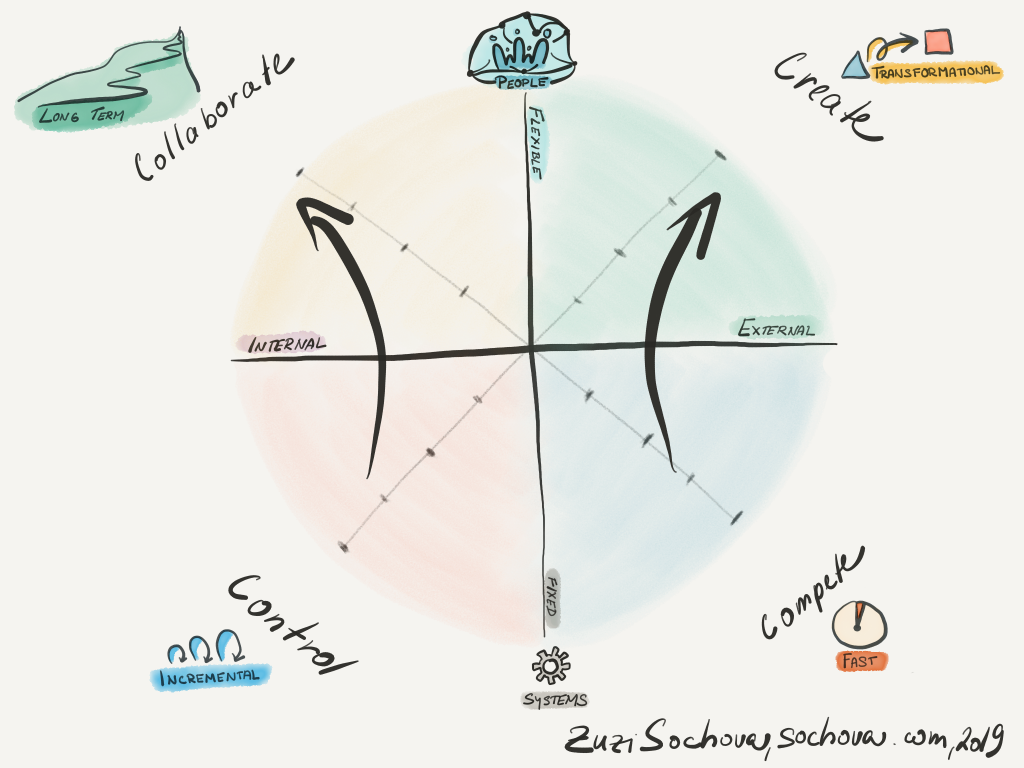I already wrote here that during the agile journey, the Agile HR changes the entire focus from being compliant driven to focus on overall employee experience. Agile HR is about leadership, system coaching, and large groups facilitation. And there is another layer. Agile HR should shape the culture. Yes, that’s right. There is an interesting framework of Competing Values which is in a very simple way describing culture as a tension between control and creative quadrants and competing and collaborative quadrants. The traditional organizations were grounded in the control and competition hemisphere, having the fixed processes, hierarchy and competition at the both individual and organizational level, while the agile organizations are more leaning towards the collaboration and creativity hemisphere changing the focus from individuals to the teams and networks, having higher level of autonomy and empowerment, forming partnerships instead of fighting with competitors.
As organizations continue on their agile journey, the culture is shifting and sooner or later the practices need to follow. For example, having a very hierarchical narrow position structure becomes an obstacle of a higher level of collaboration and self-organization. The silos are in the way of the cross-functional teams so the first step is to get rid of traditional positions i.e. Developer, Analyst, Tester and create a team member position as in the cross-functional team that’s all we need. The steep carrier path gets in the way of collaboration from the other side so organizations usually descale and become (more) flat as they rely more on intrinsic over extrinsic motivation. Speaking about motivation, how many of you are motivated by performance review and KPIs? None? That’s right. So what’s the other option? When we remove the individual goals and KPIs together with the performance review, how can we assure people get actionable feedback? So instead of artificial annual performance conversation, we invest into creating a learning environment where people learn from failures, get frequent peer feedback and mentoring from their colleagues so they can co-create their journey and grow as individuals and teams together. It’s not that much about any magical practices, but more about coaching and facilitation skills – that’s where ScrumMasters could be quite helpful. And I guess I can continue.
And keep in mind, it’s not about practices, processes, and tools, those can only support or make your journey harder. It’s about having a strong sense of purpose, common values, and joined identity. Once you have it, the practices will follow in a very natural way. So where to start? Think about your organization, where your culture is right now, and then think about where you need to be to keep up with nowadays business challenges and stay competitive. Only then, you are ready to assess individual practices. Are they supporting that shift? Are they indifferent? Or are they in the way of the desired culture shift?

 Learn more about transforming organizations, leadership, and culture with Agile & Enterprise Coaching. Check our Scrum and Agile training sessions on Sochova.com. Grab a copy of The Great ScrumMaster: #ScrumMasterWay book and The Agile Leader: Leveraging the Power of Influence book.
Learn more about transforming organizations, leadership, and culture with Agile & Enterprise Coaching. Check our Scrum and Agile training sessions on Sochova.com. Grab a copy of The Great ScrumMaster: #ScrumMasterWay book and The Agile Leader: Leveraging the Power of Influence book.
Disclaimer: All I write on this blog is purely personal and has no relation with any position I have, used to have or will have in the future.


